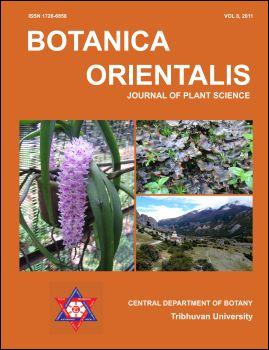Epiphytic lichens as indicator of land-use pattern and forest harvesting in a community forest in west Nepal
DOI:
https://doi.org/10.3126/botor.v8i0.5555Keywords:
biodiversity, community forestry, parmeloid, phorophytesAbstract
Human inhabitance and agriculture have fundamentally altered global pattern of biodiversity and ecosystem processes. Therefore, integration of community-based approach is an effective conservation strategy. Community forestry is an important community-based approach, which can help in conserving local ecological assets in a sustainable manner. Lichens are known to be more sensitive indicators of ecosystem functions and disturbances than any other cryptogam and vascular plant community. Present study reports a preliminary assessment of epiphytic lichens in a community forest in Dadeldhura district, west Nepal, in order to identify potential indicator of forest health and land-use pattern. Epiphytic (corticolous) lichens were sampled from ten land-use units (LUU), using narrow frequency grids of 10 cm × 50 cm, each divided into five sampling units of 10 cm × 10 cm, on the bark of selected tree species. Quercus leucotrichophora was the dominant phorophyte followed by Pinus roxburghii, Rhododendron arboreum and Myrica esculenta. Foliose parmeloid (Parmotrema spp., Heterodermia spp., Hypotrachyna spp., Bulbothrix spp., Canoparmelia spp., Canomaculina spp.) was the most abundant lichen group, found inhabiting all the phorophytes followed by crustose, fruticose and dimorphic growth forms. Maximum diversity of parmeloid lichens was recorded on older stand of Quercus while younger stands usually harbored crustose lichens (e.g., Lecanora spp., Basidia spp.). Though the lichen diversity increased from outer fringes of the forest to the core, the vegetation stand age was not distributed in any consistent pattern suggesting unconstrained harvesting of the forest. Lichen diversity was found constrained by phorophyte determinants (stand age, aspect, and bark properties) and community harvesting of the forest.
doi: http://dx.doi.org/10.3126/botor.v8i0.5555
Botanica Orientalis – Journal of Plant Science (2011) 8: 24-32
Downloads
Downloads
Published
How to Cite
Issue
Section
License
This license enables reusers to copy and distribute the material in any medium or format in unadapted form only, for noncommercial purposes only, and only so long as attribution is given to the creator.




